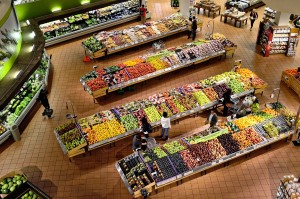Next time you feel bad about dipping your hand into a bag of potato chips, remember that you’re not alone. In fact, a new study shows that about half of what Americans consume can be categorized as “junk food.”
In the study, which was published in BMJ Open, “junk food” was defined as ultra-processed food (think added sugar and salt). The researchers looked at 9,317 subjects and discovered that junk food contributed to 57.9 percent of their energy intake. About 89.7 percent of their energy intake could be directly linked to added sugars.
 Out of all of the individuals evaluated in the study, research showed that only those whose ultra-processed food consumption was within the lowest 20 percent had an average daily added sugar intake that fell below the maximum recommended limit.
Out of all of the individuals evaluated in the study, research showed that only those whose ultra-processed food consumption was within the lowest 20 percent had an average daily added sugar intake that fell below the maximum recommended limit.
Ultra-processed foods are those we all typically reach for to quickly quell our hunger — packaged snacks, packaged baked foods, reconstituted meat products (We’re look at you, chicken nuggets), and instant noodles or soup are just to name a few.
“Cutting back on the consumption of ultra-processed foods could be an effective way of curbing excessive added sugar intake in the U.S.,” the researchers concluded in their report.
But did that really even need to be said?
It’s obvious that the sheer amount of processed and ultra-processed food marketed at the grocery store is playing a role in how we eat, as well as our health. However, we’re still in charge of what we buy and consume. Here are some tips to keep in mind next time you’re in the supermarket:
- Take a look at the labels. While it may take a little bit of research outside of the grocery store to buff up on what all of this data means, there is one easy piece of information you can look out for: serving size. The nutrition facts on the label reflect one serving. If one serving size for a bag of chips is 3 potato chips, but there are 20 servings in the bag, think of how much the percentages of salt and sugar add up to in total!
- Be mindful of fat content. “Fat free” foods must have less than 0.5 grams of fat per serving, meaning you could still get consuming it when you chow down. Instead of worrying about finding “fat free” and “reduced fat” foods, educate yourself on the benefits of monounsaturated fats instead.
- Go raw. What’s more unprocessed than the carrot or apple you pick up in the produce aisle? It doesn’t need a nutrition label, unlike a packaged frozen dinner or can of vegetables.
As always, don’t forget to talk to your doctor before you make any dietary changes or incorporate new food into your diet.
Sources
Steele, Euridice. Baraldi, Larissa. Louzada, Maria. Moubarac, Jean-Claude. Mozaffarian, Dariush. Monteiro, Carlos. “Ultra-processed foods and added sugars in the US diet.” BMJ Open. March 9, 2016.
Zelman, Kathleen. “Low-Fat Diet: Why Fat-Free Isn’t Trouble-Free.” WebMD. October 2, 2014.
